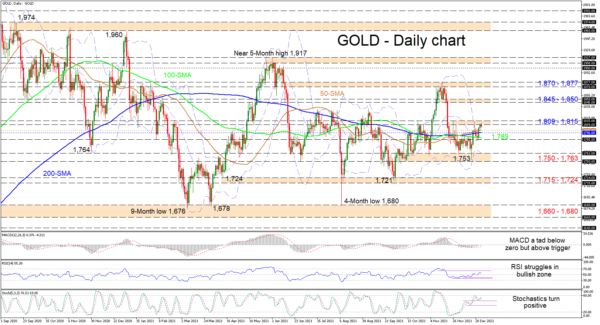Gold’s recent positive traction off the mid-Bollinger band after a price bounce within the 1,750-1,763 support region is having trouble soaring past the 1,809-1,815 resistance belt. The converged simple moving averages (SMAs) are currently not endorsing any clear trend in the pair.
That said, the short-term oscillators are skewed to the upside but are reflecting that bullish momentum remains somewhat frail. The MACD, in the negative region, is rising above its red trigger line and has neared the zero threshold, while the RSI is starting to fade in bullish territory. The stochastic oscillator has regained a positive bearing and has yet to signal any weakness in buying powers.
To the upside, immediately hindering progress in the commodity is the upper Bollinger band along with the 1,809-1,815 barrier. Now, should the price successfully push beyond the 1,815 level, the 1,845-1,850 resistance zone could step into the spotlight. Clawing higher could feed belief in additional gains however, for bullish confidence to return to the picture, the bulls would need to retain control and surpass the 1,870-1,877 boundary.
If advances are curbed by the 1,809-1,815 barricade, an initial section of support could stem from the 50-day SMA at 1,800 until the 1,785 low. If this reinforced area fails to negate fresh declines from evolving, the price may then confront the lower Bollinger band coupled with the 1,750-1,763 region of troughs, which started to unfold from mid-October. If selling interest intensifies and sinks the price of the commodity past the 1,715-1,724 border, the bears could target the 1,660-1,680 support base, which started to take shape around mid-April 2020.
Summarizing, gold is exhibiting a tendency to improve beyond the nearby band of highs from 1,809-1,815, which could boost bullish pressures. That said, directional impetus is currently lacking and for downside worries to return, the price would need to slip below the 1,750-1,763 support section.



 Signal2forex.com - Best Forex robots and signals
Signal2forex.com - Best Forex robots and signals




